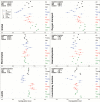Men Sustain Higher Dysregulation Levels Than Women Without Becoming Frail
- PMID: 28977345
- PMCID: PMC5861919
- DOI: 10.1093/gerona/glx146
Men Sustain Higher Dysregulation Levels Than Women Without Becoming Frail
Abstract
The aging process differs in important ways between the sexes, with women living longer but at higher risk for frailty (the male-female health-survival paradox). The underlying biological mechanisms remain poorly understood, but may relate to sex differences in physiological dysregulation patterns. Here, using biomarkers from two longitudinal cohort studies (InCHIANTI and BLSA) and one cross-sectional survey (NHANES), we assess sex differences in trajectories of dysregulation globally and for five physiological systems: oxygen transport, electrolytes, hematopoiesis, lipids, and liver/kidney function. We found higher dysregulation levels in men, both globally and in the oxygen transport and hematopoietic systems (p < .001 for all), though differences for other systems were mixed (electrolytes) or absent (lipids and liver/kidney). There was no clear evidence for sex differences in rates of change in dysregulation with age. Although risk of frailty and mortality increase with dysregulation, there was no evidence for differences in these effects between sexes. These findings imply that the greater susceptibility of women to frailty is not simply due to a tolerance for higher dysregulation; rather, it may actually be men that have a greater tolerance for dysregulation, creating a male-female dysregulation-frailty paradox. However, the precise physiological mechanisms underlying the sex differences appear to be diffuse and hard to pin down.
Keywords: Biomarker; Dysregulation trajectory; Homeostasis; Physiological systems; Statistical distance.
© The Author(s) 2017. Published by Oxford University Press on behalf of The Gerontological Society of America. All rights reserved. For permissions, please e-mail: journals.permissions@oup.com.
Figures



References
-
- Bourbeau R. Canadian mortality in perspective: a comparison with the United States and other developed countries. Can Stud Popul. 2002;29:313–369. doi:10.25336/P64P4N
-
- Kochanek KD, Murphy SL, Xu J. Deaths: final data for 2011. Natl Vital Stat Rep. 2015;63:1–120. - PubMed
-
- Wardle J, Haase AM, Steptoe A, Nillapun M, Jonwutiwes K, Bellisle F. Gender differences in food choice: the contribution of health beliefs and dieting. Ann Behav Med. 2004;27:107–116. doi:10.1207/s15324796a - PubMed
-
- Fried LP, Tangen CM, Walston J et al. ; Cardiovascular Health Study Collaborative Research Group Frailty in older adults: evidence for a phenotype. J Gerontol A Biol Sci Med Sci. 2001;56:M146–M156. doi:10.1093/gerona/56.3.M146 - PubMed
Publication types
MeSH terms
Substances
Grants and funding
LinkOut - more resources
Full Text Sources
Other Literature Sources
Medical

